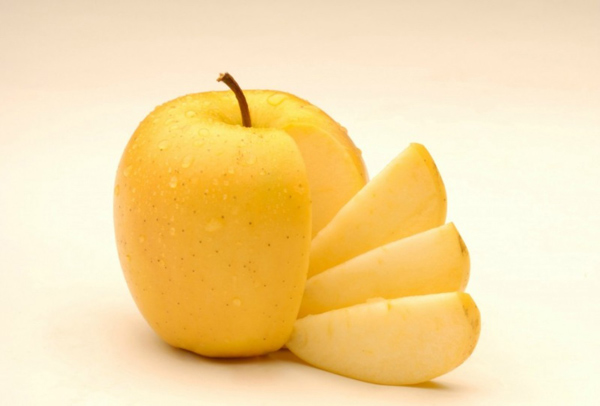當(dāng)前位置: Language Tips> 雙語新聞
The apple that never browns wants to change your mind about genetically modified foods
分享到
蘋果削皮后如果不馬上吃掉,沒過一會兒整個果肉表層就會被氧化變成褐色,讓人看上去毫無食欲。如今美國已經(jīng)生產(chǎn)出了永不氧化變色的蘋果,而且很快就要上市銷售。不變色的蘋果好是好,但因?yàn)檫@種蘋果是轉(zhuǎn)基因水果,到底還是讓人心里不踏實(shí)。樂觀的商家認(rèn)為,如果這種蘋果在市場上獲得成功,就會打消人們對轉(zhuǎn)基因食品的恐懼,但是批評者則認(rèn)為,消費(fèi)者還是應(yīng)該保持懷疑態(tài)度。

After years of development, protest and regulatory red tape, the first genetically modified, non-browning apples will soon go on sale in the United States.
歷經(jīng)多年研發(fā)與非議,經(jīng)受了監(jiān)管部門條條框框的約束,終于,首款防褐變轉(zhuǎn)基因蘋果就要在美國開售了。
The fruit, sold sliced and marketed under the brand Arctic Apple, could hit a cluster of Midwestern grocery stores as early as Feb. 1. The limited release is an early test run for the controversial apple, which has been genetically modified to eliminate the browning that occurs when an apple is left out in the open air.
這種備受爭議的“北極蘋果”預(yù)計(jì)最早于2017年2月1日在美國中西部的多家商店以切片的形式進(jìn)行初期的試點(diǎn)銷售。因?yàn)榻?jīng)過了轉(zhuǎn)基因改良,這種蘋果的果肉暴露在空氣中不會發(fā)生氧化變色。
Critics and advocates of genetic engineering say that the apple could be a turning point in the nation’s highly polarizing debate over genetically modified organisms (GMOs). While genetic modifications have in the past been mainly defended as a way to protect crops, the Arctic Apple would be one of the first GMOs marketed directly to consumers as more convenient.
基因工程的批評家們與支持者們均表示,美國國內(nèi)在轉(zhuǎn)基因生物的爭論上,觀點(diǎn)已呈兩極化,“北極蘋果”的試售可能會是這一局面的轉(zhuǎn)折點(diǎn)。在過去,轉(zhuǎn)基因技術(shù)主要運(yùn)用于農(nóng)作物的保護(hù),而切片包裝的“北極蘋果”因其方便食用,將成為消費(fèi)者直接吃進(jìn)嘴里的第一種轉(zhuǎn)基因水果。
“What companies are desperate for is some really popular GMO product to hit the market,” said McKay Jenkins. “Any successful product could lift the cloud over GMOs.”
麥凱?詹金斯表示:“企業(yè)渴望的是真正受市場歡迎追捧的轉(zhuǎn)基因產(chǎn)品。任何轉(zhuǎn)基因商品在市場上的成功都可能會打消人們對轉(zhuǎn)基因生物的疑慮。”
Industry executives predict the apple could open a whole new trade in genetically engineered produce, potentially opening the market to pink pineapples, antioxidant-enriched tomatoes, and other food currently in development.
業(yè)內(nèi)高管預(yù)測,“北極蘋果”可以為轉(zhuǎn)基因農(nóng)產(chǎn)品打開一個全新市場,同時也為今后把粉色菠蘿,抗氧化西紅柿等尚在研發(fā)的轉(zhuǎn)基因食物推向市場做好了鋪墊。
“We see this as less about genetic modification and more about convenience,” said Neal Carter, founder of the company that makes the Arctic Apple. “I think consumers are very ready for apples that don’t go brown. Everyone can identify with that ‘yuck’ factor.”
“北極蘋果”的生產(chǎn)商、加拿大奧卡諾根特色水果公司創(chuàng)始人尼爾?卡特認(rèn)為:“在我們看來,該蘋果的重點(diǎn)在于食用便利而非其轉(zhuǎn)基因的身份。我相信消費(fèi)者能夠接受不變色的蘋果。也能包容別人所謂的瑕疵。”
GMO critics say they are hopeful, however, that consumers will continue to show skepticism about the produce. Despite a growing consensus in scientific circles that GMOs pose little risk, environmental and consumer groups have successfuly mounted campaigns against GMOs over the past 30 years, successfully limiting the practice to commodity crops like soybeans and corn.
轉(zhuǎn)基因生物的批評者們則表示,他們希望消費(fèi)者們能繼續(xù)對轉(zhuǎn)基因產(chǎn)品保持懷疑態(tài)度。盡管科學(xué)界對轉(zhuǎn)基因生物幾乎無風(fēng)險的事實(shí)已逐漸認(rèn)可,但在過去30年里,反對轉(zhuǎn)基因生物的環(huán)境組織和消費(fèi)者團(tuán)體的宣傳力量不可小覷,這樣一來就大大限制了大豆和玉米等農(nóng)作物商品的轉(zhuǎn)基因研究。
Anti-GMO groups have successfully pushed for GMO crop bans in places like Boulder County, Colo., and Sonoma County, Calif., and several major food brands have agreed not to use GM ingredients. Critics have also questioned how consumers will be able to judge the freshness of sliced apples when they don’t brown.
反轉(zhuǎn)基因生物組織已成功地推動了科羅拉多州博爾德縣和加州索諾瑪縣的轉(zhuǎn)基因作物種植禁令,幾大主要食品品牌也就不使用轉(zhuǎn)基因原料達(dá)成了共識。同時,評論家們提出,如果轉(zhuǎn)基因的切片蘋果不會氧化變色,消費(fèi)者要如何判斷水果是否新鮮。
“This apple is understudied, unlabeled, and unnecessary,” said Dana Perls, the senior food and technology campaigner with environmental nonprofit Friends of the Earth. “It’s only a matter of time before consumers realize they’re being falsely marketed to … And then there will be an uproar.”
非盈利環(huán)保組織“地球之友”的資深食品和技術(shù)活動家德納?帕爾斯表示:“這種轉(zhuǎn)基因蘋果仍有待研究,它不該與普通蘋果混在一起賣,它的上架甚至是完全多余的。消費(fèi)者遲早會意識到自己被市場誤導(dǎo)愚弄,這只不過是時間問題。到那時將會一片嘩然。”
Most Americans already consume a large number of GMOs or GMO-derived ingredients every day. Over ninety percent of all corn and soybeans grown in the US are engineered to improve agricultural efficiency and withstand frequent pesticide applications. The resulting corn and soy are frequently fed to animals intended for human consumption, or routed into processed foods as corn starch, corn syrup, soy lethicin and dozens of other derivatives.
大多數(shù)美國人每天已然在消費(fèi)大量的轉(zhuǎn)基因或含轉(zhuǎn)基因成分的食物。美國對國內(nèi)所種植的90%以上的玉米和大豆都進(jìn)行了品種改良,以此來提高農(nóng)業(yè)生產(chǎn)效率,使其禁得起殺蟲劑的頻繁使用。這些玉米大豆常用作肉用家禽飼料,或加工成玉米淀粉、玉米糖漿、大豆卵磷脂等食品和其他數(shù)十種衍生產(chǎn)品。
This non-browning technology could theoretically be applied later to any number of tree fruits, including pears and cherries, which Okanagan’s scientists have already begun to research.
理論上,這種防褐變技術(shù)將會大量應(yīng)用于梨樹、櫻桃樹等果樹,奧卡諾根公司的科學(xué)家們已經(jīng)開始著手研究了。
英文來源:華盛頓郵報
翻譯:羅玲敏(中國日報網(wǎng)愛新聞iNews譯者)
編審:丹妮
上一篇 : 美國數(shù)名議員提議退出聯(lián)合國
下一篇 : 職場各“族”生存之道
分享到
關(guān)注和訂閱

關(guān)于我們 | 聯(lián)系方式 | 招聘信息
電話:8610-84883645
傳真:8610-84883500
Email: languagetips@chinadaily.com.cn